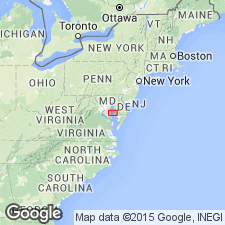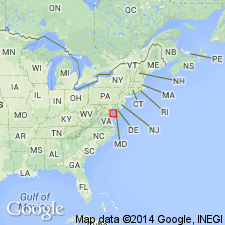
- Usage in publication:
-
- Drumcliff Member
- Modifications:
-
- Named
- Dominant lithology:
-
- Sand
- AAPG geologic province:
-
- Atlantic Coast basin
Summary:
Drumcliff Member of Choptank Formation here named in St. Marys Co., southeastern MD. Extends to northeastern VA. Unit is composed of yellow-brown to orange sand characterized by beds of densely packed large shells alternating with beds of small shells. Measures 9.2 m at its type section on Patuxent River. Gradationally overlies Calvert Beach Member (new name) and conformably underlies St. Leonard Member (new name), both of Choptank Formation. Age is middle Miocene.
Source: GNU records (USGS DDS-6; Reston GNULEX).

- Usage in publication:
-
- Drumcliff shell bed
- Modifications:
-
- Revised
- AAPG geologic province:
-
- Atlantic Coast basin
Summary:
Though unit was elevated to formal member status by Gernant (1970), author retains informal usage "to avoid name proliferation." Bed reaches a maximum thickness of 8 m. Shell content varies from 20 to 70 percent. Unit unconformably underlies Boston Cliffs shell bed and unconformably overlies Kenwood Beach shell bed. Age given as late Miocene. [See also Kidwell, 1989: Journal of Geology, v. 97, no. 1, p. 1-24.]
Source: GNU records (USGS DDS-6; Reston GNULEX).

- Usage in publication:
-
- Drumcliff Member*
- Modifications:
-
- Overview
- AAPG geologic province:
-
- Atlantic Coast basin
Summary:
The sediment of the Drumcliff Member of the Choptank Formation is described here as pale yellowish-brown to very pale orange, slightly muddy to very well sorted, fine sand. At the base, the sediment is usually dusky-blue to dusky-green, very fine to fine sand. According to the author, the most distinct characteristic is the "prolific accumulation of shells, in some places so densely packed that there is scarcely any sediment." Thickness ranges from about 6 to 30 ft. The best exposures are in MD west of the Chesapeake Bay; unit is difficult to identify in VA. Gradationally overlies the Calvert Beach Member of the Calvert Formation; underlies the St. Leonard Member of the Choptank. Age is middle Miocene.
Source: GNU records (USGS DDS-6; Reston GNULEX).
For more information, please contact Nancy Stamm, Geologic Names Committee Secretary.
Asterisk (*) indicates published by U.S. Geological Survey authors.
"No current usage" (†) implies that a name has been abandoned or has fallen into disuse. Former usage and, if known, replacement name given in parentheses ( ).
Slash (/) indicates name conflicts with nomenclatural guidelines (CSN, 1933; ACSN, 1961, 1970; NACSN, 1983, 2005, 2021). May be explained within brackets ([ ]).

